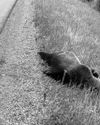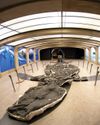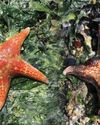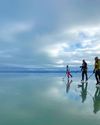
FORTY-FIVE YEARS AGO, Brenda Peterson, the daughter of a rancher, didn’t want Grasslands National Park to exist. In 1975, standing at a packed community hearing in Mankota, Sask., the petite, just-married university student studying education, her hair a mop of chestnut curls, spoke passionately against the park. The Saskatchewan Natural History Society first proposed the preserve in the mid-1950s, and, two decades later, the provincial and federal governments were finally considering it. “I said, ‘My family has looked after this place since 1911,’” she recalls. “‘You think I’m just going to give it to the park? We’re doing a fine job.’” But her group’s protests failed. In 1981, Parks Canada and Saskatchewan signed an agreement to establish the park, and Parks Canada subsequently bought two ranches totalling 140 square kilometres in the Frenchman River area. But when conditions in the agreement about oil and gas exploration and water resource management proved to be unworkable, the acquisition of additional park lands stopped. It wasn’t until 1988 that Saskatchewan and Parks Canada revised their agreement and proceeded with establishing the park, which today is divided into the East Block and West Block and encompasses about 900 square kilometres. Almost overnight, it seemed to Peterson, parks staff posted DO NOT ENTER signs, outraging locals. “One time, they stopped my brother and said he was trespassing — on his own land,” says Peterson. “The park people didn’t know where the border was.”
Now, sitting comfortably on horseback, Peterson, 62, overlooks her family’s historical ranching lands from atop a massive ridge, the wind-whipped grass peeling down along the hillside. She squints into the sun, the horizon a sweep of greys and greens, browns and tans.
This story is from the {{IssueName}} edition of {{MagazineName}}.
Start your 7-day Magzter GOLD free trial to access thousands of curated premium stories, and 9,000+ magazines and newspapers.
Already a subscriber ? Sign In
This story is from the {{IssueName}} edition of {{MagazineName}}.
Start your 7-day Magzter GOLD free trial to access thousands of curated premium stories, and 9,000+ magazines and newspapers.
Already a subscriber? Sign In

ANIMAL XING
THIS PAST SUMMER AN AMBITIOUS WILDLIFE UNDER/OVERPASS SYSTEM BROKE GROUND IN B.C. ON A DEADLY STRETCH OF HIGHWAY JUST WEST OF THE ALBERTA BORDER. HERE’S HOW IT HAPPENED.

Unearthing a giant
Almost 30 years ago, paleontologist Elizabeth “Betsy” Nicholls made a discovery of colossal proportions

WE DID THIS
AS THE IMPACTS OF GLOBAL WARMING BECOME INCREASINGLY EVIDENT, THE CONNECTIONS TO BIODIVERSITY LOSS ARE HARD TO IGNORE. CAN THIS FALL’S TWO KEY INTERNATIONAL CONFERENCES POINT US TO A NATURE-POSITIVE FUTURE?

The COOLEST COUNTRY
“The coolest country” celebrates the wonders of winter with an all-Canadian theme. The 20-page travel planner includes a bucket list from travel writer Robin Esrock, steamy spa ideas, ice fishing destinations, festival fun, northern itineraries and more!

KEEPER of the SEA
FROM BEING LABELLED DEVIL’S APRON BY FRUSTRATED FISHERMEN TO BEING LAUDED AS A SUSTAINABLE FOOD SOLUTION: HOW KELP’S POTENTIAL IS BEING REALIZED, JUST AS SCIENTISTS LEARN IT’S DECLINING

WILD THINGS
WILD CANADIAN GEOGRAPHIC PRESENTS THE WINNERS OF ITS ANNUAL CANADIAN WILDLIFE PHOTOGRAPHY OF THE YEAR COMPETITION

AN EMPTY LANDSCAPE
AFTER MORE THAN A MILLION YEARS ON EARTH, CARIBOU ARE UNDER THREAT OF GLOBAL EXTINCTION. THE PRECIPITOUS DECLINE OF THE ONCE MIGHTY HERDS IS A TRAGEDY THAT IS HARD TO WATCH — AND EVEN HARDER TO REVERSE.

NORTHERN EXPOSURE
BON INTO A CARIBOU-HUNTING CREE FAMILY IN NORTHERN MANITOBA, ACCLAIMED PLAYWRIGHT AND NOVELIST. TOMSON HIGHWAYS PAYS TRIBUTE TO THE MAGICAL WORLD OF HIS CHILDHOOD IN PERMANENT ASTONISHMENT

INTO THE ARCTIC
CANADIAN PAINTER AND FILMMAKER CORY TRÉPANIER EXPLORES THE SUBLIME AND RAPIDLY CHANGING CANADIAN ARCTIC

Under the ice
Until the last decade, we knew little about what lay beneath the Arctic ice. Now scientists and explorers are shedding light on this vanishing world.